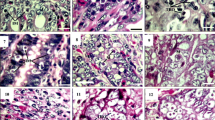Abstract
C3H mice were infected with 30 metacercarial cysts of either echinostome to study the pathological, ultrastructural, and cytochemical effects of the infection on the mouse small intestine. In mice infected withEchinostoma caproni, the intestine showed villous atrophy with fused or eroded villi. The microvilli of the enterocytes were sparse and distorted and showed reduced alkaline phosphatase activity. The crypts of Lieberkuhn were hyperplastic and showed a marked reduction in goblet and Paneth cells. As compared with uninfected controls, there was a marked reduction in glucose-6-phosphatase activity in the enterocytes of the infected gut. Collagen fibers and the number of fibroblasts were increased under the epithelium. In mice infected withE. trivolvis, the tips of the intestinal villi were bent and blunted. The microvilli of the enterocytes were less tightly packed than those of uninfected controls. The mitochondria in the enterocytes were irregularly shaped, contained intracristal bodies, and showed increased cytochrome oxidase activity as compared with those of uninfected controls. The crypts were hyperplastic but showed an increase in the numbers of goblet and Paneth cells. The fibroblasts and collagen fibers showed abnormal development. The ultrastructural and cytochemical differences seen in this study reflect the uniqueness of the host-parasite relationship of each of these echinostome species in the gut of the C3H mouse.
Similar content being viewed by others
References
Barker IK (1975a) Intestinal pathology associated withTrichostrongylus colubriformis infection in sheep: histology. Parasitology 70:165–171
Barker IK (1975b) Intestinal pathology associated withTrichostrongylus colubriformis infection in sheep: vascular permeability and ultrastructure of the mucosa. Parasitology 70:173–180
Beaver PC (1937) Experimental studies onEchinostoma revolutum (Froelich). A fluke from birds and mammals. Ill Biol Monogr 15:1–96
Bindseil E, Christensen NØ (1984) Thymus-independent crypt hyperplasia and villous atrophy in the small intestine of mice infected with the trematodeEchinostoma revolutum. Parasitology 88:431–438
Bogitsh BJ, Wikel SK (1974)Schistosoma mansoni: ultrastructural observations on the small intestine of the murine host. Exp Parasitol 35:68–79
Christensen NØ, Fried B, Kanev I (1990) Taxonomy of 37-collar spinedEchinostoma (Trematoda: Echinostomatidae) in studies on the population regulation in experimental rodent hosts. Angew Parasitol 31:127–130
Fujino T, Fried B, Tada I (1993) The expulsion ofEchinostoma trivolvis: worm kinetics and intestinal cytopathology in conventional and congenitally athymic BALB/c mice. Parasitology 106 (in press)
Gomori G (1950) An improved histochemical technique for acid phosphatase. Stain Technol 25:81–85
Hosier DW, Fried B (1986) Infectivity, growth and distribution ofEchinostoma revolutum in Swiss Webster and ICR mice. Proc Helminthol Soc Wash 53:173–176
Huffman JE, Fried B (1990)Echinostoma and echinostomiasis. Adv Parasitol 29:215–269
Huffman JE, Michos C, Fried B (1986) Clinical and pathological effects ofEchinostoma revolutum (Digenea: Echinostomatidae) in the golden hamster,Mesocricetus auratus. Parasitology 93:505–515
Hugon JS, Borgers M, Maestracci D (1970) Glucose 6-phosphatase and thiamine pyrophosphatase activities in the jejunal epithelium of the mouse. J Histochem Cytochem 18:361–364
Hugon JS, Maestracci D, Ménard D (1971) Glucose 6-phosphatase activity in the intestinal epithelium of the mouse. J Histochem Cytochem 19:515–525
Jeyarasasingam U, Heyneman D, Lim H-K, Mansour N (1972) Life cycle of a new echinostome from Egypt,Echinostoma liei sp. nov. (Trematoda; Echinostomatidae). Parasitology 65:203–222
Karnovsky MM (1965) A formaldehyde-glutaradehyde fixative of high osmolality for use in electron microscopy. J Cell Biol 27:137A-138A
Kim S, Fried B (1989) Pathological effects ofEchinostoma caproni (Trematoda) in the domestic chick. J Helminthol 63:227–230
Mayahara H, Hirano H, Saito T, Ogawa K (1967) The new lead citrate method for the ultracytochemical determination of activity of non-specific alkaline phosphatase (ortho-phosphoric monoester phosphohydrolase). Histochemie 11:88–96
Ménard D (1980) Ultrastructural localization of intestinal glucose-6-phosphatase activity during the postnatal development of the mouse. Histochemistry 67:53–64
Nordlie RC (1979) Multifunctional glucose-6-phosphatase:cellular biology. Life Sci 24:2397–2404
Odaibo AB, Christensen NØ, Ukoli FMA (1988) Establishment, survival and fecundity inEchinostoma caproni (Trematoda) infections in NMRI mice. Proc Helminthol Soc Wash 55:265–269
Olson LJ, Richardson JA (1968) Intestinal malabsorption ofd-glucose in mice infected withTrichinella spiralis. J Parasitol 54:445–451
Roberts-Thomson IC, Grove DI, Stevens DP, Waren KS (1976) Suppression of giardiasis during the intestinal phase of trichinosis in the mouse. Gut 17:953–958
Robinson JM, Karnovsky MJ (1983) Ultrastructural localization of several phosphatases with cerium. J Histochem Cytochem 31:1197
Seligman AW, Karnovsky MJ, Wasserkurg H, Hanker JS (1968) Nondroplet ultrastructural demonstration of cytochrome oxidase activity with a polymerizing osmiophilic reagent, diaminobenzidine (DAB). J Cell Biol 38:1–14
Simonsen PE, Bindseil E, Køie M (1989)Echinostoma caproni in mice: studies on the attachment site of an intestinal trematode. Int J Parasitol 19:561–566
Symons LEA, Fairbairn D (1962) Pathology, absorption, transport, and activity of digestive enzymes in rat jejunum parasitized by the nematodeNippostrongylus brasiliensis. Fed Proc 21:913–918
Symons LEA, Gibbins JR, Jones WO (1971) Jejunal malabsorption in the rat infected by the nematodeNippostrongylus brasiliensis. Int J Parasitol 1:179–187
Tani S, Yoshimura K (1988) Spontaneous expulsion ofEchinostoma hortense Asada, 1926 (Trematoda: Echinostomatidae) in mice. Parasitol Res 74:495–497
Wachstein M, Meisel E (1956) On the histochemical demonstration of glucose-6-phosphatase. J Histochem Cytochem 4:592
Weinstein MS, Fried B (1991) The expulsion ofEchinostoma trivolvis and retention ofEchinostoma caproni in the ICR mouse: pathological effects. Int J Parasitol 21:255–257
Author information
Authors and Affiliations
Rights and permissions
About this article
Cite this article
Fujino, T., Fried, B. Expulsion ofEchinostoma trivolvis (Cort, 1914) Kanev, 1985 and retention ofE. caproni Richard, 1964 (Trematoda: Echinostomatidae) in C3H mice: pathological, ultrasturctural, and cytochemical effects on the host intestine. Parasitol Res 79, 286–292 (1993). https://doi.org/10.1007/BF00932183
Received:
Accepted:
Issue Date:
DOI: https://doi.org/10.1007/BF00932183




